
Scottish crystal paperweight by John Deacons, millefiori star design
Scottish crystal paperweight, handmade in Scotland by John Deacons, millefiori star form interior banded by helix canework, on lime grounds, initialled in cane with label

Anemone Millefiori Crystal Paperweight: Yellow Ground Twisted Cane Design
Strathern crystal paperweight, anemone design with millefiori interspersed with white twisted cane on yellow ground

Baccarat Scrambled Pattern Paperweight, 19th Century French Collectible
Baccarat Scrambled pattern paperweight, 19th, circa French Baccarat paperweight 'End of day Scramble' a bed of upset Latticinio Muslin and colourful twisted tubes, circa 1850

1848 Baccarat Paperweight with Spaced Canes on Upset Muslin Ground
Baccarat 19th century. Paperweight, dated 1848 spaced canes on upset muslin ground, signed and dated

19th Century Millefiori Glass Paperweight, Antique, 4cm x 6.5cm
An antique millefiori glass paperweight, 19th century, 4 cm high, 6.5 cm diameter
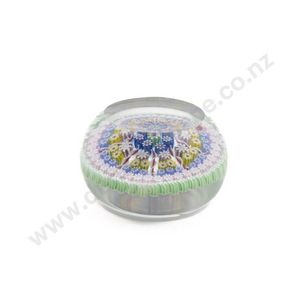
Millefiori Glass Paperweight: Flattened Top Design by Caithness
Caithness glass paperweight, millefiori design with flattened top
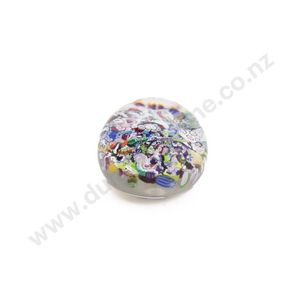
1972 Perthshire Scramble Millefiori Glass Paperweight with Stamped Central Cane
Small Perthshire Scramble glass paperweight, with millefiori canes, central cane stamped P 1972
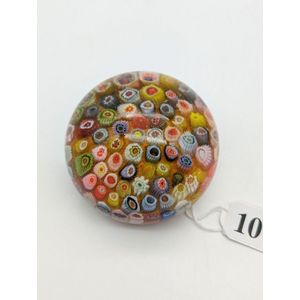
Vibrant Millefiori: Multicolored Paperweight on Yellow Ground
art glass paperweight, multi-coloured millefiori against yellow ground
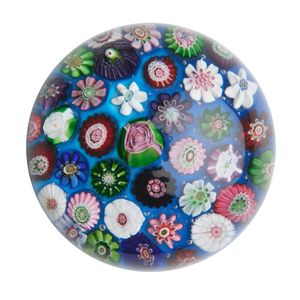
Clichy Millefiori Paperweight with Rare Purple Rose
An antique Clichy scattered millefiori paperweight, the scattered millefiori on an opaque turquoise ground with a large central classic Clichy rose cane surrounded by an assortment of pretty pastry mould and cog canes, three additional rose canes in white…
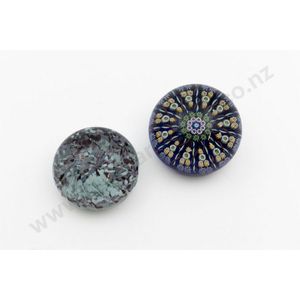
Perthshire Glass Millefiori Paperweight with Central Cane Stamp
Perthshire glass millefiori paperweight & other millefiori weight central cane stamped P

Perthshire Glass Millefiori Paperweight with Ship and P Cane
Boxed Perthshire glass millefiori paperweight one cane marked P 1972 and another decorated with a sailing ship

1974 Millefiore Art Glass Paperweight
Millefiore art glass paperweight, dated to outer flower 1974 (Perthshire?)

Millefiori Perthshire Glass Paperweight
Perthshire glass paperweight, millefiori multi coloured canes
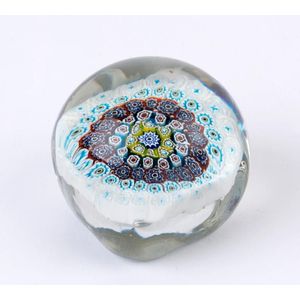
Millefiori Glass Paperweight, 19th Century
An antique millefiori glass paperweight of squarish form, 19th century, 8 cm high
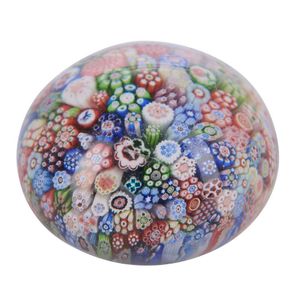
Baccarat Millefiori Paperweight, 1847
A miniature French millefiori paperweight, by Baccarat, dated 1847, featuring a close packed assortment of complex millefiori amoung picture canes and gridel silhouette canes. Signature and date cane 'B/ 1847', 3.5 cm high, approximately 6 cm diameter
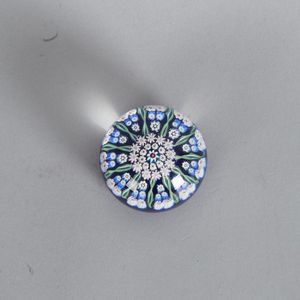
Murano Millefiori Paperweight - 4.5cm x 6.5cm
A Murano millefiori paperweight, height 4.5 cm, depth 6.5 cm
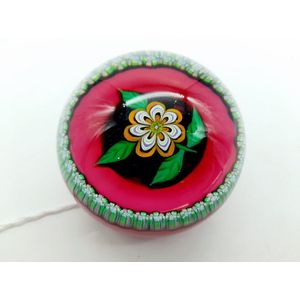
Mauve Flower Millefiori Glass Paperweight
art glass paperweight, central mauve colour base, flower head and leaf decoration surrounded by circular millefiori edging
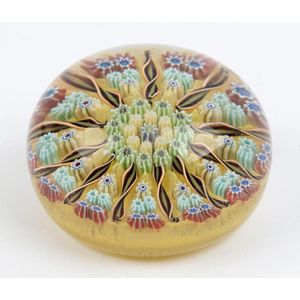
Vintage Millefiori Glass Paperweight, 20th Century
Millefiori vintage glass paperweight, 20th century, 4 cm high, 6.5 cm diameter
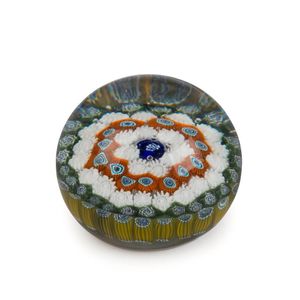
Limited Edition French Millefiori Glass Paperweight with Certificate
Saint Louis French millefiori glass paperweight with original certificate and box, 20th century, limited edition 343/500, 6 cm high, 8 cm diameter.
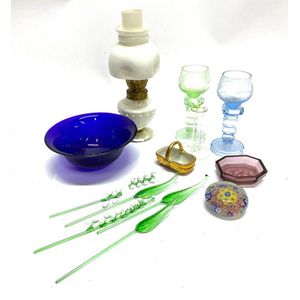
Glass Collection: Lantern and Millefiori Paperweight
A collection of glass including a milk glass oil lantern, a millefiori paperweight

Millefiori Glass Paperweight, 20th Century
A millefiori glass paperweight, 20th century, 4.5 cm high, 8 cm diameter
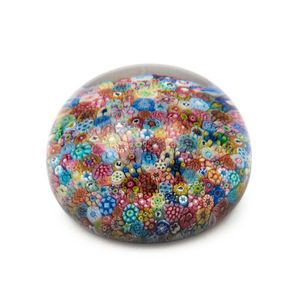
Baccarat Millefiori Glass Paperweight with Acid Etched Mark
Baccarat French millefiori glass paperweight, 20th century, acid etched factory mark. 5 cm high, 8 cm diameter
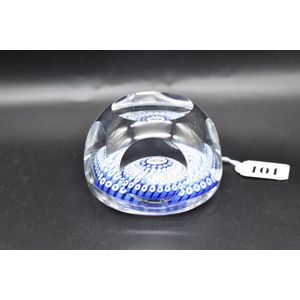
Millefiori Owl Paperweight by Whitefriars Art Glass
Whitefriars millefiori owl art glass paperweight
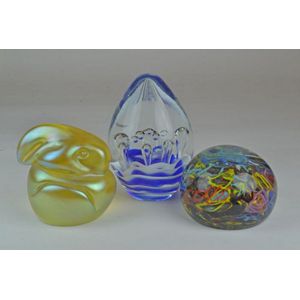
Assorted Glass Collectibles
3 x paperweights i.Modernist, unknown maker, with rising bubbles, from a blue & white 'Wavy' ocean. Height 10.5 cm ii.Orient & Flume, iridescent glass rabbit. Inscribed on base, plus #664. Height 7 cm iii.Unknown maker, 'Scrambled spaghetti' design'.
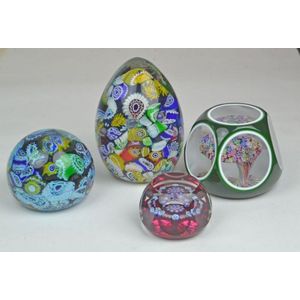
Fine 19th Century Paperweights with Millefiori and Porthole Designs
4 x fine paperweights 2 of, likely by Clichy, 'Scrambled millefiori', design, 19th century. (both with abrasions). Heights 10 cm & 5 cm 2 of with porthole design. Likely by Clichy or Baccarat i.Clear & red glass, 6 side portholes plus one at the top. Very…
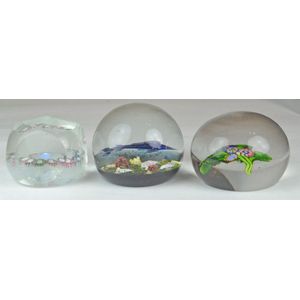
Three Unique Paperweights with Scottish and French Designs
3 x paperweights i.Caithness (Scotland), 'Horoscope' 1/1, signed ii.Caithness (Scotland), 'Blue Marlin' (titled on base) iii.Maker unknown, perhaps Baccarat or Clichy. Depicts a central plant with 'Millefiore' canes as the flowers.
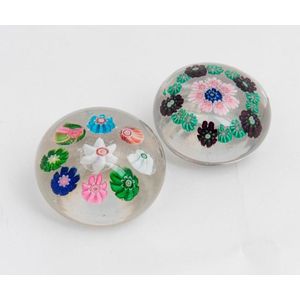
Clichy Millefiore Miniature Paperweights, 1850
Two Clichy millefiore miniature paperweights, circa 1850, one with a central white floret and eight encircling canes including a distinctive Clichy rose, the other with concentric wreath form florets in green and aubergine encircling a central pale pink…
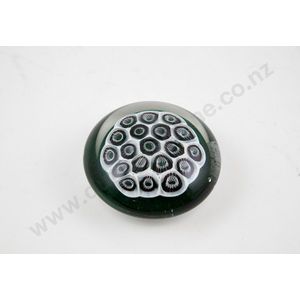
Brendon Sole Etched Signature Paperweight
Brendon Sole Wanganui New Zealand paperweight, white green encased canes etched signatures 5/08 10 cm diameter.
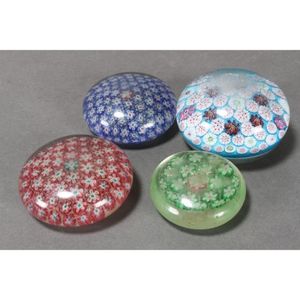
Millefiori Flower Glass Paperweights (Set of 4)
Four early millefiori glass paperweights, decorated with flower heads in green, blue and red (4)
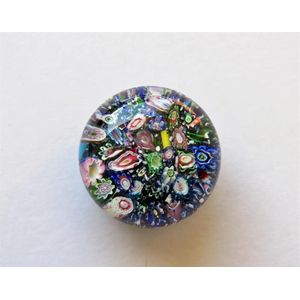
Clichy Millefiori Glass Paperweight from 19th Century
19th century glass paperweight. Clichy close millefiori weight. Diameter 5 cm. Collection Dr John Raven, Perth.
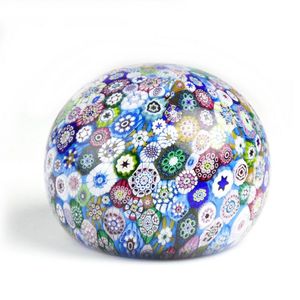
St. Louis Millefiori Paperweight with Box & Certificate
A St Louis paperweight, multi-coloured millefiori canes, one cane marked and dated, with original box and certificate.
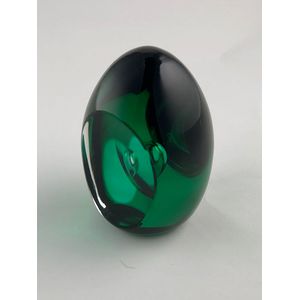
Millefiori & Reflecting Bubble Paperweights
Murano paperweight concentric millefiori and Kosta reflecting bubble paperweight

Baccarat Millefiori Garland Paperweight
Antique Baccarat paperweight millefiori garland pattern on white ground
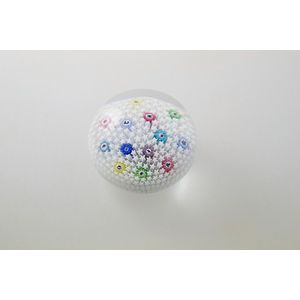
Baccarat Zodiac Canes on Star Carpet Paperweight
Paperweight, Baccarat scattered zodiac canes on star carpet ground
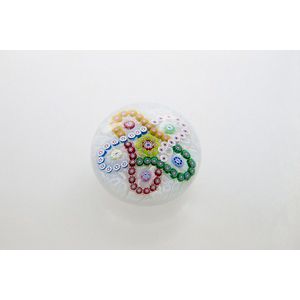
St. Louis Millefiori Paperweight, 1875
Paperweight, St Louis millefiori garlandon latticino, dated 1875
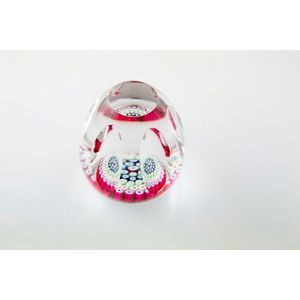
Whitefriars Millefiori Finger Cut Paperweight (1971)
Paperweight, Whitefriars millefiori finger cut 1971
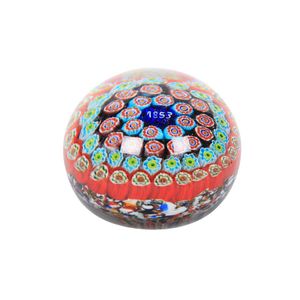
Curved Millefiori Paperweight, 1853 Marked
Paper weight, curved, with millefiori centre, marked 1853
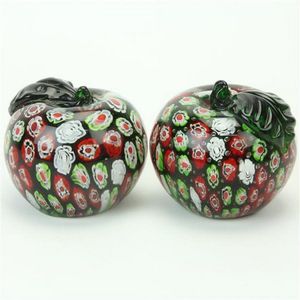
Castellani Millefiori Apple Paperweights with Stickers
Murano Castellani millefiori pair of apple paperweights with original stickers. Height 7.5 cm
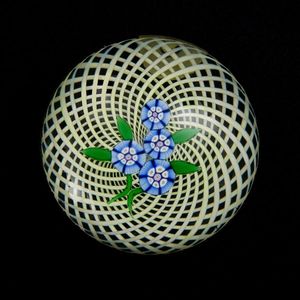
Scottish Millefiori Glass Paperweight with Forget-Me-Not Pattern
Large Scottish Perthshire millefiori and Twist Cane Glass Paperweight, c. 1976, Forget-Me-Not' pattern, depicting flowers on a yellow and green double spiral latticino cushion, incised 'P1976', with box and certificate, diameter 7 cm
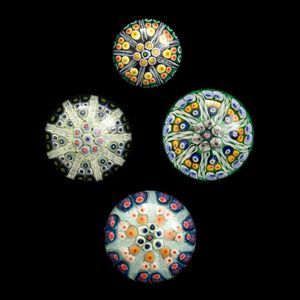
Scottish Strathearn Millefiori Glass Paperweights (Set of 4)
Four Scottish Strathearn millefiori Glass Paperweights, c. 1965-1979, with one large seven, two nine and a medium nine spoke cartwheel designs on translucent ground (4), approx. diameter 8 cm

Scottish Millefiori Glass Paperweight with Twist Canes
Large Scottish Perthshire millefiori and Twist Cane Glass Paperweight, c. 1976, limited edition, with star shape pattern outlined by twist canes, incised 'P1976' and numbered 115/450, with box and certificate, diameter 7.6 cm
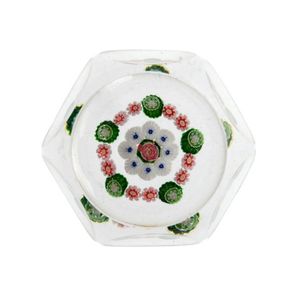
French Millefiori Glass Paperweight, 1850
French Clichy Faceted millefiori Glass Paperweight, c. 1850, the central pink and green rose cane encircled by a concentric ring of white and blue canes, and bordered by a garland of red cog canes, alternating with pairs of white and red canes, on clear…
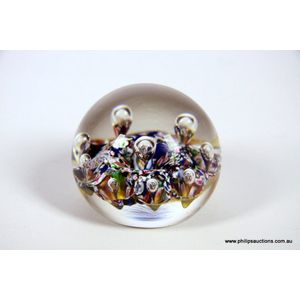
Signed Paul Ysart Harlequin Scottish Paperweight (6cm, 1971)
A fine signed Paul Ysart 'Harlequin' Scottish paperweight, from 1971, with paper label of Paul Harland Studio, harlequin pattern PY3008 from the Paul Ysart pattern book, with striking controlled 'Bouncing' bubbles encased in the clear glass dome rising…
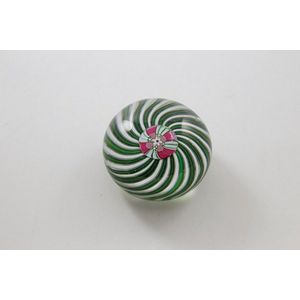
Green and white swirl paperweight from 19th century Clichy
Mid 19th century Clichy swirl paperweight green and white canes
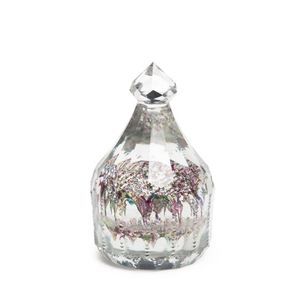
Italian Millefiori Cut Glass Paperweight, 19th Century
An unusual cut glass millefiori paperweight, Italian, mid 19th century, 17 cm high, 11 cm diameter

1850 Millefiori Paperweight Perfume Bottle with Glass Stopper
Millefiori paperweight perfume bottle dated 1850 having a flat base with four layers of varying millefiore flowers with a central '1850' date mark & a glass stopper with three layers of flowers with another central flower. Condition, good to fair, some…

Millefiore Murano Paperweight with Label
Murano millefiore paperweight, with part original paper label
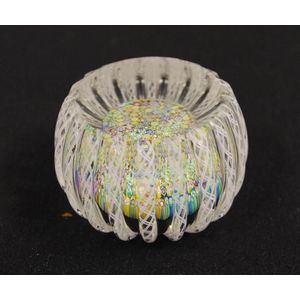
1991 Millefiori Glass Paperweight - Vintage Collectible
Vintage millefiori glass paperweight dated 1991
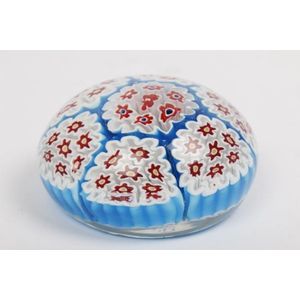
Millefiori Murano Glass Paperweight in Blue, White & Red
Paperweight. Murano glass 'Millefiori' blue white & red
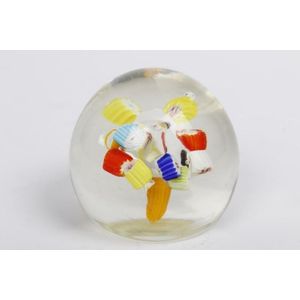
Murano Cane Cluster Paperweight
Paperweight. Frateli Tosco Vetreria Murano clusters of canes Around a central clear bubble
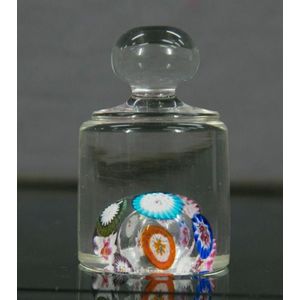
Millefiori Clear Glass Paperweight with Open Bubble Base
Millefiori & clear glass paperweight. Open bubble to base. Height 7.5 cm
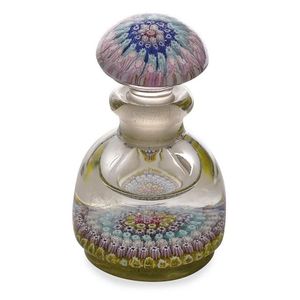
Millefiori Inkwell Paperweight with Colorful Bands
A 19th century millefiori inkwell paperweight, possibly Stourbridge, the base and the mushroom shaped stopper decorated with concentric bands of colourful millefiori canes, (stopper slightly scratched), 10 cm high
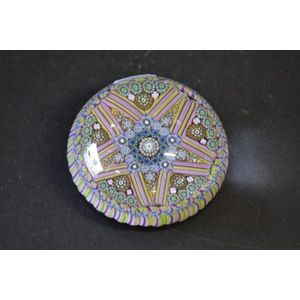
Limited Edition Perthshire Millefiori Paperweight (1986)
Perthshire magnum patterned millefiori paperweight (box and certificate) 1986 128/300
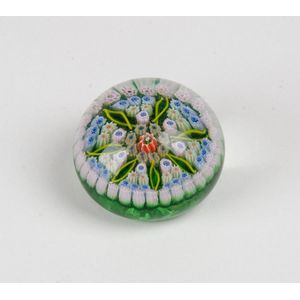
Millefiori Glass Paperweight - 20th Century
A millefiori glass paperweight, 20th century. 6 cm diameter
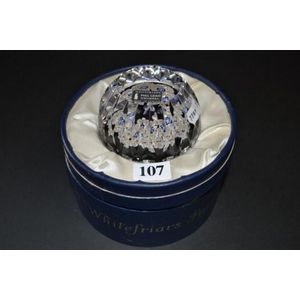
Millefiori Crystal Paperweight in Box
Whitefriars full lead cut crystal millefiori paperweight, boxed
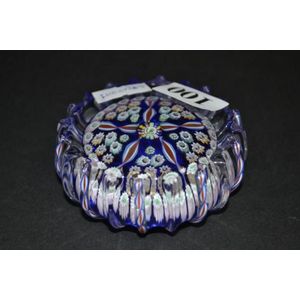
Decon Scottish Millefiori Paperweight
Scottish millefiori paperweight by John Decon (with original paper label)
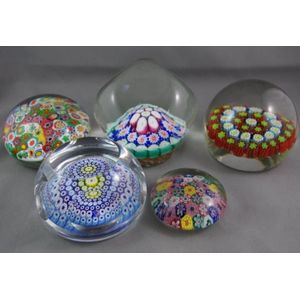
Millefiori Glass Paperweights Collection - 5 Pieces
Whitefriars millefiori glass paperweight, together with 4 other millefiori paperweights
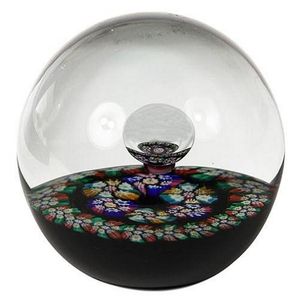
"Millefiori Reflections" Paperweight
Caithness 'Millefiori Reflections' art glass paperweight with the traditional millefiore ring pattern base & a suspended bubble which reflects the image of the millefiore crance, in a fitted silk lined box. Height 8 cm
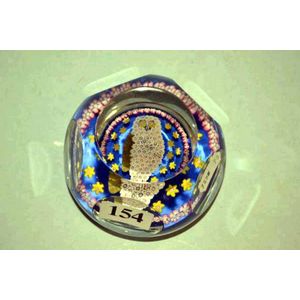
Millefiori Owl Faceted Paperweight in Original Case
Whitefriars millefiori owl faceted paperweight (in original case)
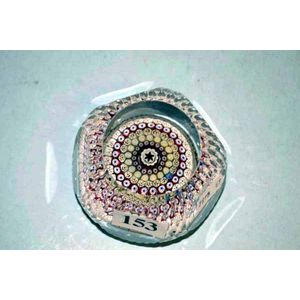
Concentric Millefiori Faceted Paperweight in Original Case
Whitefriars concentric millefiori faceted paperweight (in original case)
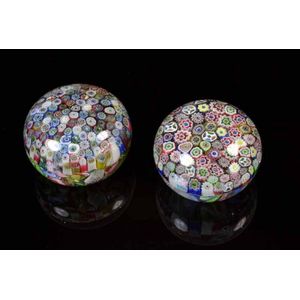
Mid-century Murano millefiori glass paperweights (2)
Two Murano millefiori glass paperweights mid 20th century Diameters: 7.8 cm & 8 cm
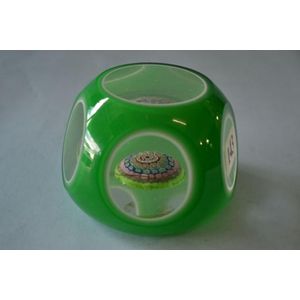
Concentric Millefiori Faceted Paperweight
Overlay faceted paperweight with concentric and millefiori canes
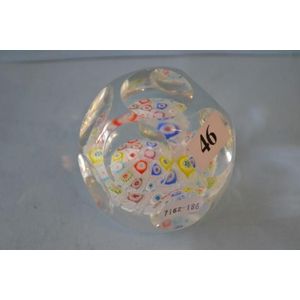
Faceted Murano Millefiori Paperweight
Murano faceted paperweight, spaced millefiori on muslin ground (label)
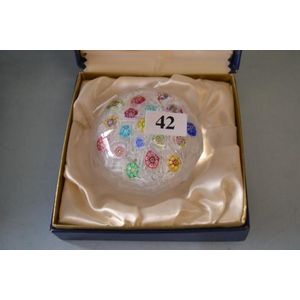
Spaced Millefiori Baccarat Paperweight with Faceted Sides
Baccarat paperweight, spaced millefiori on muslin ground, faceted sides (in case)
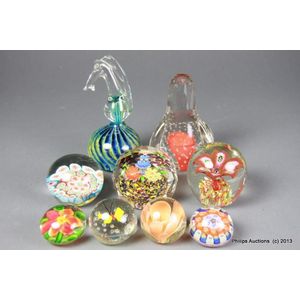
Assorted Glass Paperweights Collection
A collection of forty seven paperweights, a mixed selection including floral, figural, and advertising pieces, some in the Saint Louis manner, fabricated in a variety of glass making techniques including millefiori cane work, latticinio, controlled bubble…
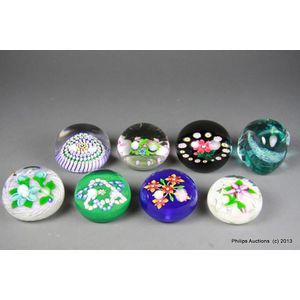
Scottish Paperweight Collection with Floral and Millefiori Examples
A Notable collection of eight Scottish paperweights, later 20th century, a fine selection of floral, millefiori and latticinio examples including three John Deacons' weights, labelled and/or with initialled canes; a Caithness 'Pebble', number B10160m; two…
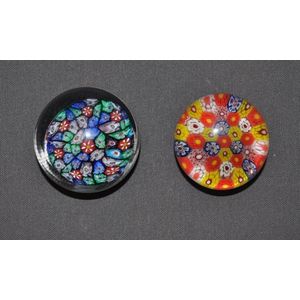
Millefiori Glass Paperweights - Set of Two
Two various millefiori glass paperweights. Diameter 6 cm. (average)
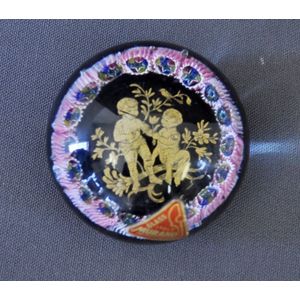
Millefiori Glass Paperweight with Original Label - 7cm Diameter
Murano millefiori glass paperweight. Original label attached. Diameter 7 cm
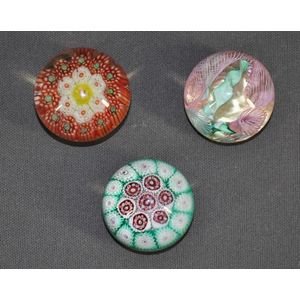
Small Glass Paperweights - Millefiori and Latticino (Set of 3)
Three various small glass paperweights. Two millefiori and One latticino. Diameter 4 cm. (each)
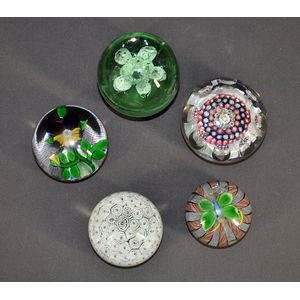
Assorted Floral Glass Paperweights (Chipped)
Five various glass paperweights, including two millefiori and three other floral decorated. Chips. Diameter 8 cm. (average)






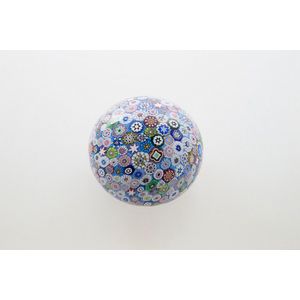



















 Loading more...
Loading more...